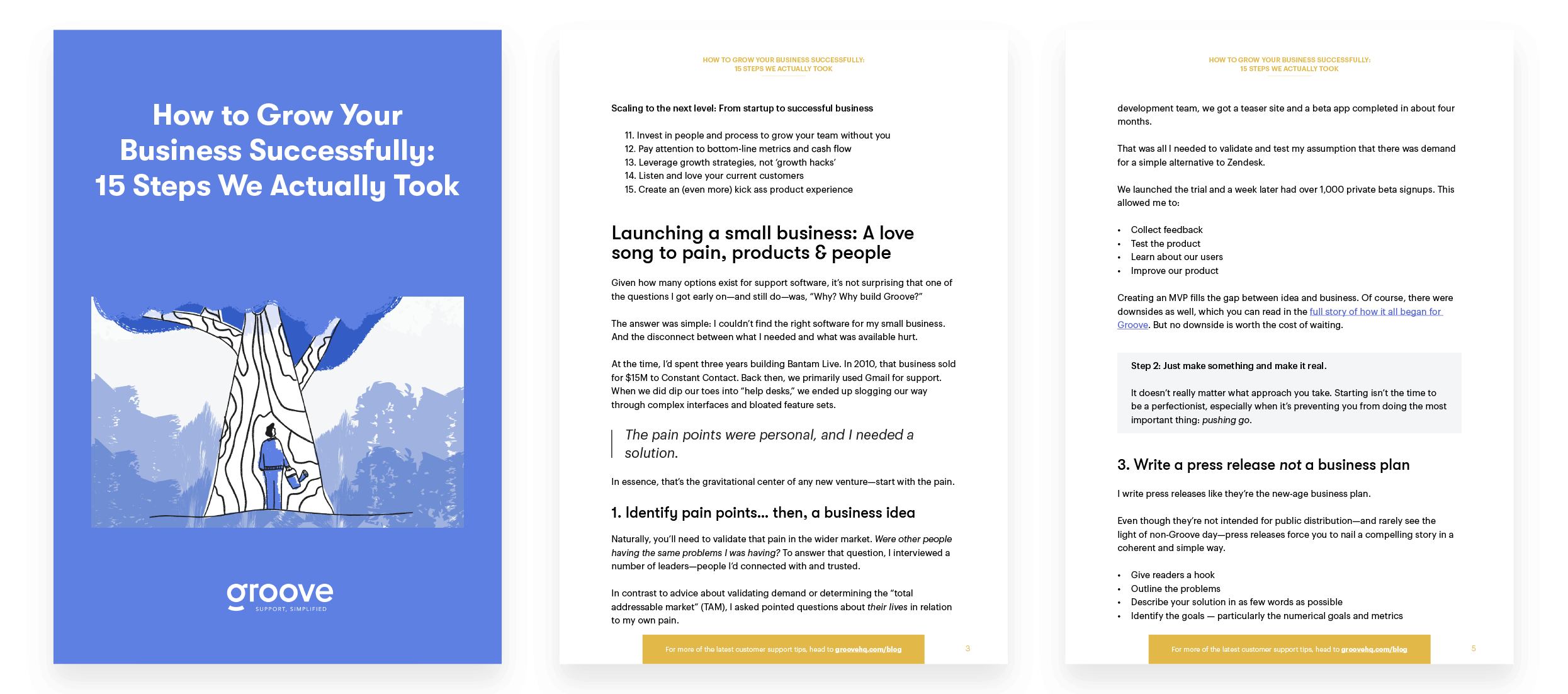After seven years, 2,000+ customers, and growing from $0 to $290K+ in monthly revenue, I want to pull back the curtain on exactly what it takes to grow a business. Good, bad, and ugly.
I almost shut the whole thing down.
It was two years ago.
Our business had stagnated. My head of marketing had just left.
I didn’t know if it was worth it anymore.
Those are the dark times. The moments entrepreneurs rarely talk about.
Growing a business isn’t all sunshine and rainbows.
It has tremendous highs. And deep lows.
We’ve tried a lot of growth strategies over the last seven years.
Many of them didn’t work for us.
But a few have been… honestly… really great.
That’s what I want to show you: the field-proven growth strategies we’ve tried, refined, and found to be successful.
What follows is a comprehensive guide to grow your business—broken into three stages and 15 steps.
Launching a small business: A love song to pain, products & people
- Identify pain points… then, a business idea
- Create a minimum viable product
- Write a
business planpress release - Get to you know your potential customers
- Really get to know your new customers
Growing your new business: Cost-effective marketing strategies that work
- Use content marketing to drive organic search
- Own your social media channels but be cautious of ‘paid’
- Build your email list (by any means necessary)
- Hold to your core values and question them
- Shift to a business owner mindset
Scaling to the next level: From startup to successful business
- Invest in people and process to grow your team without you
- Pay attention to bottom-line metrics and cash flow
- Leverage growth strategies, not ‘growth hacks’
- Listen and love your current customers
- Create an (even more) kick ass product experience

Launching a small business: A love song to pain, products & people
Given how many options exist for support software, it’s not surprising that one of the questions I got early on—and still do—was, “Why? Why build Groove?”
The answer was simple: I couldn’t find the right software for my small business. And the disconnect between what I needed and what was available hurt.
At the time, I’d spent three years building Bantam Live. In 2010, that business sold for $15M to Constant Contact. Back then, we primarily used Gmail for support. When we did dip our toes into “help desks,” we ended up slogging our way through complex interfaces and bloated feature sets.
The pain points were personal, and I needed a solution.
In essence, that’s the gravitational center of any new venture—start with the pain.
1. Identify pain points… then, a business idea
Naturally, you’ll need to validate that pain in the wider market. Were other people having the same problems I was having? To answer that question, I interviewed a number of leaders—people I’d connected with and trusted.
In contrast to advice about validating demand or determining the “total addressable market” (TAM), I asked pointed questions about their lives in relation to my own pain.
Beyond truly category-creating products and services—which are far more rare than entrepreneurs like to think—your initial problem won’t be quantifying TAM, but having the courage to enter a competitive space.
I knew demand was out there. Customer service, customer experience, and customer relationship management (CRM) are massive marketers with huge players.
Don’t let the big names deter you. Rather than fear competition, embrace it.
Join the conversations and actively listen with your coworkers, friends, or a random stranger in a cafe. Seek out online communities where people congregate to talk about problems—like Reddit, Twitter, and Quora. Stalk your soon-to-be competitor’s own FAQs, reviews, and especially their online forums.
Search for words or phrases where the intent is to solve a problem:
- “How do I”
- “I can’t seem to”
- “Help, I’m struggling to”
Step 1. Find the pain.
You don’t have to have a unique business idea. What you do have to have is a problem to solve. Once you’ve found the former, only then work out how you can do the two things that every business needs to do to succeed: (1) deliver value and (2) profit from it.
2. Create a minimum viable product
Once I had the idea to create Groove, that’s literally all I had. No prototype, no customers and no funding. Zilch!
The first version was outsourced. Working closely with a small four-person development team, we got a teaser site and a beta app completed in about four months.
That was all I needed to validate and test my assumption that there was demand for a simple alternative to Zendesk.
We launched the trial and a week later had over 1,000 private beta signups. This allowed me to:
- Collect feedback
- Test the product
- Learn about our users
- Improve our product
Creating an MVP fills the gap between idea and business. Of course, there were downsides as well, which you can read in the full story of how it all began for Groove. But no downside is worth the cost of waiting.
Step 2: Just make something and make it real.
It doesn’t really matter what approach you take. Starting isn’t the time to be a perfectionist, especially when it’s preventing you from doing the most important thing: pushing go.
3. Write a press release, not a business plan
I write press releases like they’re the new-age business plan.
Even though they’re not intended for public distribution—and rarely see the light of non-Groove day—press releases force you to nail a compelling story in a coherent and simple way.
- Give readers a hook
- Outline the problems
- Describe your solution in as few words as possible
- Identify the goals—particularly the numerical goals and metrics
- Write them in the past tense (as though they’ve already been accomplished)
- And then, make up quotes from customers to put flesh on it.
Do whatever you need to in order to nail the story.
Here’s the first page of the one I wrote way back in 2011…


Step 3: Write your story as a press release.
Prospects care very little about your business. They care about themselves and their problems—we all do. Create a story your customers can buy into by painting a vision of the future.
4. Get to know your potential customers
Nearly every mistake we made can be attributed to not understanding our customers well enough.
For instance, early on, we spent $50K building the wrong site and the wrong product. Another time, we lost $12,000 by discounting and, as a result, reduced the perceived value of our product. More recently, we dramatically increased retention by lowering the price.
Do those last two sound contradictory? They’re not.
Again and again, we screwed up because we didn’t hold fast to what is perhaps the most important principle in business: conversations with customers and prospects are the most valuable assets you have.
How do you get better acquainted? A lot of customer development… with the right tools.
Sure, much can be done “by hand”—one-to-one emails, social media conversation, video conferences, and phone calls. But we also gained extremely valuable insight by using a number of data collection apps:
- KISSmetrics for deep insights into our visitors and customers
- Crazy Egg for helping us understanding where our site was failing
- Qualaroo for breakthrough lessons about why visitors weren’t converting
I talk to many entrepreneurs who think that some of these apps are too expensive. They say things like, “When we get big enough, we’ll pay for it.”
We wouldn’t have gotten big enough without paying for it. These apps have paid for themselves many times over in improving revenue, helping us position our messaging better, and giving us insight into the minds of our customers.
Step 4: Collect firsthand data on your customers.
Research isn’t sexy nor easy. It is, however, the only way to get a deep understanding of your audience and customers that will put you ahead of your competitors.
Still, apps aren’t everything. And neither is one-on-one data collection. The two need to work together…
5. Really get to know your new customers
Customer development is an intensive, ongoing process. We’re learning new things every day, and we don’t set limits on how far to take customer development.
Breaking through comes when you balance tools and data with person-to-person conversations.
For the latter, use a mixture of proactive and reactive methods to better understand how customers interact with your product or service and what they think of it.
(1) Get proactive with email
We send an email to every customer asking them why they signed up. We started this in the early days of Groove and continue to do so today.


This email has single-handedly given us a wealth of insights into the triggers that cause people to sign up for Groove, and we’ve been able to apply those to our marketing with tremendous results.
(2) Stay on top of inbound support requests
There’s a reason that I, as a CEO, spend more than half of my time doing customer support: it’s that valuable.
Getting to see exactly what our customers think and feel—love and hate—about our app is a huge advantage when it comes to what to build, fix, and upgrade next.
All businesses have to do customer service, but we’ve made it a crucial part of our customer development flow.
(3) Mix quantitative with qualitative
We continue to proactively send Net Promoter Score surveys to gauge customer loyalty and, more importantly, collect qualitative feedback from our customers.
To say that we have learned a lot would be an understatement. It gives us an accurate view of exactly what people like—and dislike—about Groove.
We have no plans to stop doing these.


(4) Prioritize one-on-one
With all of the hacks and tools out there, I’ve found that there’s still no substitute for one-on-one conversations with customers.
Round-tables in groups might work for some brands, but we have predominantly focused on speaking to each customer personally. It’s why, during the first few years, I made it a point to talk to every single Groove customer.
Nothing is better than one-on-one conversations for gathering deep insights and raw, unfiltered feedback.
Do yourself a favor and either get on chat, pick up the phone, or sign into Skype.
Step 5: Seriously, spend time with your customers.
Customer conversations are not a one-time task or a project, they’re a way of running a business—one that should never be put on the back-burner.
Growing your new business: Cost-effective marketing strategies that work
6. Use content marketing to drive organic search
Content marketing has been the single biggest driver of growth for our company.
Content. This blog. Guest blogging. Our customer service blog. Courses. And more.
Before we started blogging, traffic would come in bursts when we got news coverage or social media buzz. That’s not a sustainable way to grow, and we knew that we needed a better long-term strategy.
Evergreen traffic has helped us go from a $30k per month business at the end of year one to a $100k per month business after year two to a +$500k per month business today that ranks on the front page of Google for many of the topics we write about.

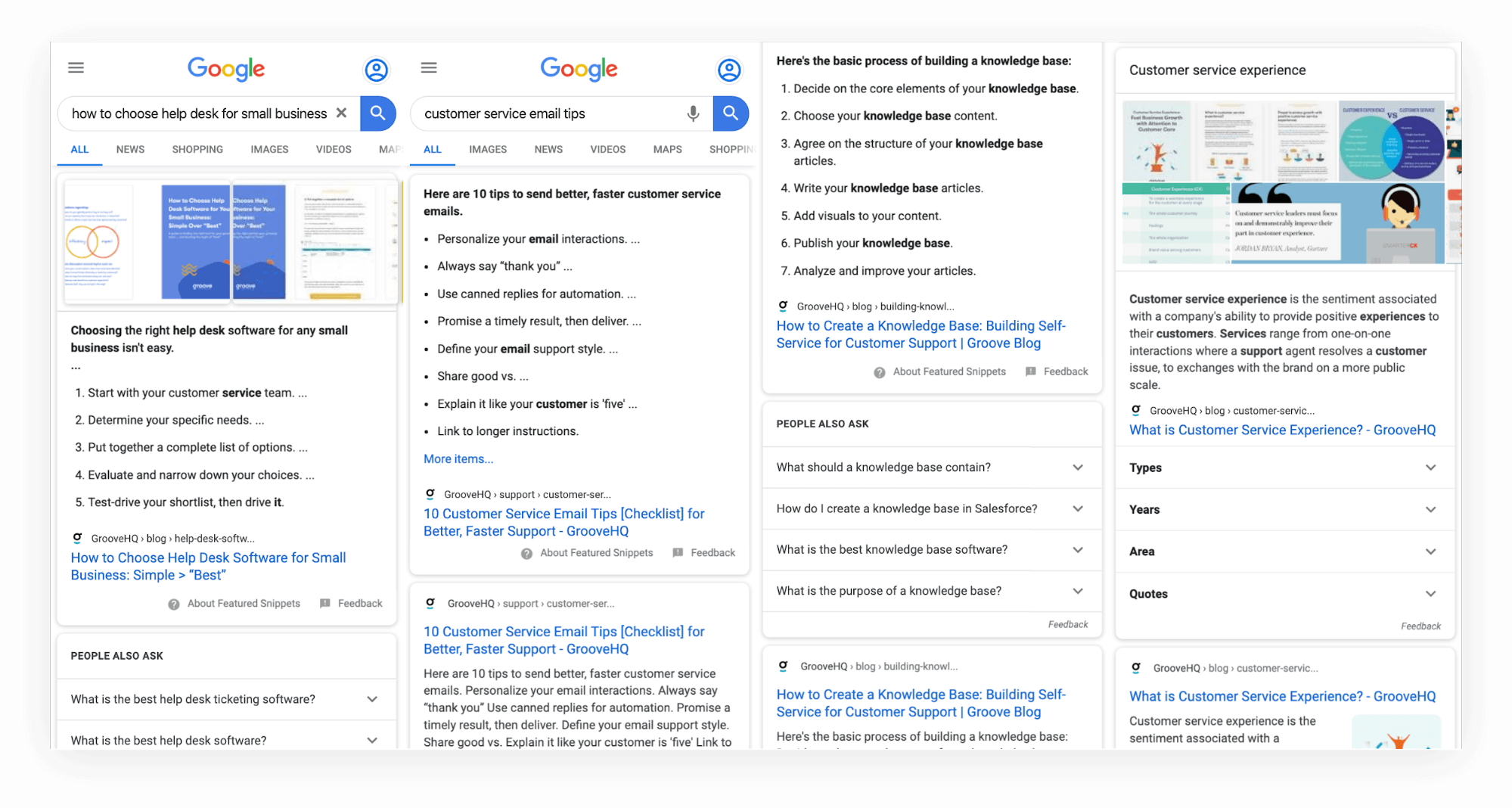
Like any strategy, the results of content marketing depend completely on setting the right goals and executing the right way. If your goal is to have a blog and you execute by writing blog posts, then that’s all you’ve accomplished.
If your goal is to build your business through content, there’s more to consider. Literally anybody can do it as long as you follow two guiding principles.
First, promote the absolute hell out of it. Within a few weeks of launching the blog, we had thousands of subscribers. That wasn’t just because the content resonated with people.
It was because we spent time building relationships with people, doing influencer engagement and promotion. When we hit “publish,” the work is only half done.


Good content is useless to your business without relentless promotion. And if, like many people, you feel “spammy” promoting your content, consider two things.
One, if your content is truly valuable, then you owe it to people to get it in front of as many eyeballs as possible. Two, influencers are influencers because they add value to their audience. If your content adds value to their audience, they’re happy to share it.
Second, optimize the absolute shit out of it. “B” content—mediocre content—is easy and plentiful. That’s why “A” content devours links and social shares. By taking a few extra hours on each post, you can exponentially increase the effect of your content.
Over time, you learn what your audience finds valuable—from topics to format and structure. The key is not to half-ass it. Invest in good, thoughtful content that solves real problems for people.
Step 6: Start blogging, right now.
It’s the single highest-return strategy we’ve implemented for user acquisition. But blogging for blogging’s sake isn’t enough. Find a specific, unique angle to deliver value to your readers, and do it better than anyone else. You’ll be rewarded forever.
Here’s a quick checklist to go from nothing to something to a massively successful blog.
5 steps to make your blog a business growth engine
- Figure out what your audience’s pains are. Send out surveys. Talk to them. Do keyword research.
- Write content that solves those pains by using the PAS structure to outline your posts: problem, agitation, solution.
- Optimize for search engines. Below you’ll see a preview of how we’ve systematized this step (along with the entire creative process).
- But don’t forget about the people. Temper SEO by using compelling images and screenshots, telling stories, citing data, and showcasing real examples.
- Build an audience who wants to hear from you. Get influencers on your side, write guest blog posts, and collect email addresses.

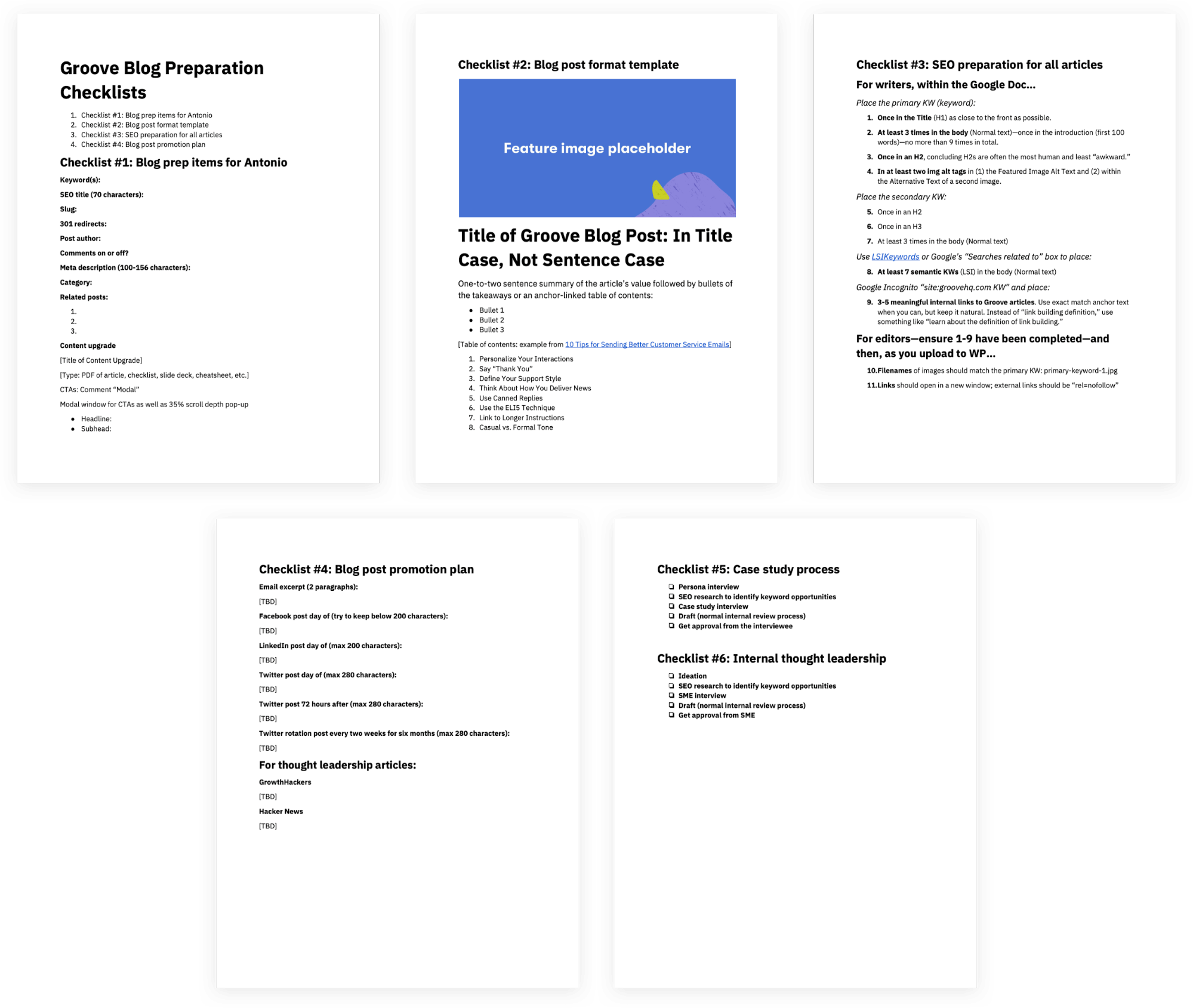
7. Own your social media channels but be cautious of ‘paid’
Our most “active” social media platform is our Twitter account. We use it as a distribution channel to promote our latest blog posts or communicate other company-related news.
But that’s about as far as we go with branded social.
Not because social media isn’t something you should consider, but you should be cautious of how quickly you can burn through your time and cash on these channels. Especially if you go the paid route.
Facebook is dominant in this space due to its targeting capabilities, allowing marketers to define and reach specific audiences that fit their target market. Google Ads rank second on the paid front—or, as it’s more broadly known, SEM (search engine marketing).
Truth be told, neither paid route has worked well for us.
Instead, invest in the organic side of social media. Test ways to encourage organic sharing and share other brand’s related content too.
What has worked for Groove is our personal accounts as an additional channel to express our brand and its story—starting with all the lessons I’ve learned about entrepreneurship:
1/
— Alex Turnbull (@alexmturnbull) July 18, 2019
They tell you not to share stories like this publicly.
“It scares customers and hurts team morale.”
Or so they say. Well, fuck ‘em. Here goes…
In late 2017, I almost walked away from the $500k/mo company I founded.
By the way, there’s a whole write-up on our blog about how you can approach content distribution for your business.
Step 7: Get active on social and be real.
Social media works quite well for some industries, but it’s not the only way to sell your product and engage your audience. If you are going to use social media for your business, make sure you have the proper resources to build out an effective strategy to avoid burning through your budgets.
8. Build your email list (by any means necessary)
Before we launched this blog, we had a few hundred email subscribers at most.
It was a ragtag bunch we’d collected through various announcements and press releases; they weren’t exactly the type of readers who would dependably become customers down the line.
And yet, 24 hours after launching our blog, we had more than 1,000 new subscribers sign up. Five weeks later, we hit 5,000 subscribers.
How? In two stages…
At first, through the power of other people’s audiences. Nearly a month before we launched the blog, we began building a list of influencers we wanted to build relationships with.
We looked for people who had the audiences we wanted to reach and who could personally get value out of our content.
Then, we began engaging with them. We left thoughtful, conversation-provoking comments on their blog posts. We shared their content. We did things that would be valuable to them wherever we could. We sent small asks that paid off big:

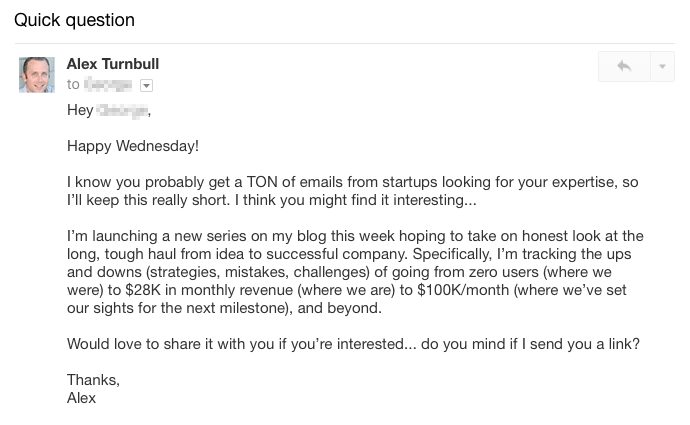
Notice that we didn’t send them the post; we asked if we could send it to them. This is a technique we learned from Derek Halpern, and immediately set us apart from the hundreds of others shoving content in the influencers’ faces.
We showed them that we respected their time and expertise, and as a result, more than 85% of the people who received that email said yes.
(Even better: when you do send a post to someone you’ve mentioned and linked to, do not ask them to share it. Instead, send them something like, “We included you in a recent post: [link to your post]. If you Ctrl + f for ‘[anchor text],’ that’ll jump you straight to your section. Could you let us know if that’s the right link?”)
As soon as we launched the blog, only then did we ask each influencer—many of whom were now invested in our success, having spent time reading and giving feedback—to share the first post.
This gave us huge exposure to audiences those influencers had spent years creating. In turn, when they shared it, that channeled tens of thousands of unique visitors—and thousands of subscribers.
Then, we got systematic. Today, we use every opportunity available to grow our email list using ConvertKit as our tool of choice. It’s pretty meta, but this post itself is a great examples:
- Static (sticky) email opt-in bar at the top
- Sidebar with a similar, but longer CTA to subscribe
- A 30% scroll-depth modal (pop-up) for the content upgrade
- Multiple in-article images, captions, and links that trigger the same modal

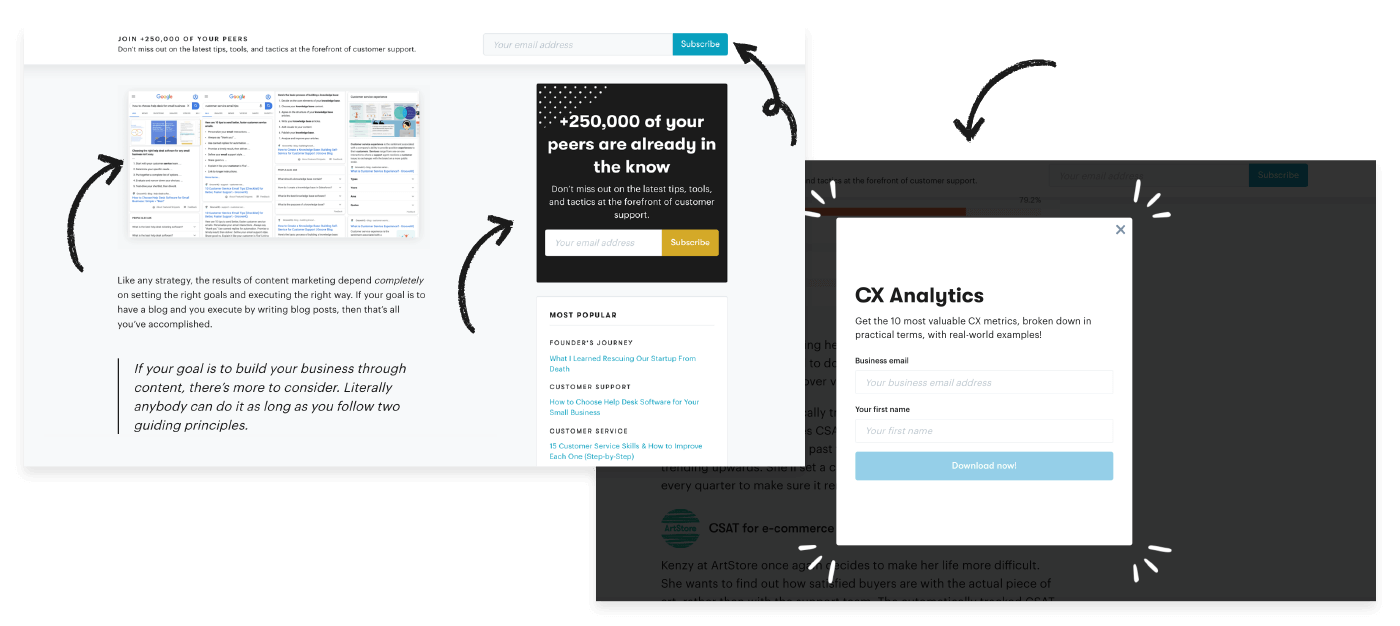
Step 8: Get those emails!
First, leverage the power of other people’s audiences. Second, never miss an opportunity to build your email list. Make it easy to opt-in at every turn.
9. Hold to your core values and question them
Core values aren’t for us, I told myself.
Core values are something that big, slow, old-fashioned companies have. They’re meaningless, churned out by people who get paid to do nothing but churn out things like core values. And they get stuck on a cheesy poster, taped to a wall, looked at once—if at all—and forgotten forever.
Boy, was I wrong.
You can read it for yourself, defining our core values transformed our business… but that didn’t last.
After I publicly declared how game-changing our core values were, we realised that some of them weren’t actually helping us.
So, we hired Elizabeth O’Neill, an experienced business coach, to get things back on track. She challenged us, guided us, and helped us define our new core values. Because of that, we’re a completely different company today.
By having someone help our leadership team question our core values, we were able to make the necessary changes. Customer satisfaction increased, team morale was much higher, and our tech started running smoothly.
Step 9: Define your values. And change from the outside in.
Don’t make the same mistake I did. I waited too long to change our core values when it was very clear they weren’t working. Also, consider hiring a business coach to help you work through them and remain impartial. For us, it was worth every cent.
10. Shift to a business owner mindset
My goal in sharing all of the lessons, stories, and learnings is to get you thinking about your own business goals. Especially how you can accomplish them strategically and systematically.
Having a business owner mindset isn’t inherited, you build it.
As much as I learned in college, I didn’t have a single class that covered marketing automation, hiring, cash flow management, growth hacking, product development, company culture, customer support, or sales.
There are a lot of things that—before starting my last company—I didn’t know how to do. As an entrepreneur, one of the scariest things in the world for me is that uncertainty.
- What am I not doing? Probably a lot.
- What if I’m doing it wrong? I probably am.
- What am I supposed to do in this situation? I have no idea.
There’s no way to make smart decisions with that sort of self-doubt.
Fortunately, it can be overcome. There are so many entrepreneurs who are smarter, more experienced and more successful than I am. Much of their wisdom is available for free on the internet.
So I dove in.
I spent an entire weekend tracking down the richest, most highly-regarded blogs and publications on the web. I listed every single one I could find, and then I devoured every post I could on those sites.
It took me three days to gather enough knowledge to take our business to the next level. For the list of blogs I came up with, check out this spreadsheet.
- Copyblogger taught me how to put together the email autoresponder that now gets delivered to every free trial user. Introducing that sequence boosted conversions by more than 30%.
- Neil Patel (via KISSmetrics) helped us write headlines that converted 2-4x better than our previous versions.
- And HubSpot convinced me to stop looking at pageviews and start looking at the metrics that actually mattered (more on that below).
This insight is all 100% free, and it has made a huge difference in the success of Groove. I still make it a priority to devote at least an hour each day to keeping up with some of the highest-value blogs on the internet.
Once you’ve done your research, you’ll have more ideas for growth strategies than you’ll know what to do with.
Step 10: Don’t just adopt an owner’s mindset, act on it.
There’s so much free advice out there for startups and small businesses, you’re robbing yourself if you don’t take advantage of it. Too many people look at reading blogs as a way to waste time, rather than the amazing investment in their business that it truly is.
Scaling to the next level: From startup to successful business
11. Invest in people and process to grow your team without you
“Are we doing everything we can to put together the right mix of talent to take Groove to the next level? How can we hire the right employees as we grow?”
Those are the questions I now ask myself on a daily basis.
Despite my best efforts to find a technical co-founder at the start, I definitely held onto people I shouldn’t have. Without this kind of knowledge, it was very difficult to trust and verify the individuals that were on the team in the early days.
I got burned a few times because of it. This is all changed in 2018 when the company had stagnated and desperately needed a shake-up.
We changed our organizational structure, hired specialists, and welcomed new routines and processes.
Ditch the generalist for a specialist
If you rely on your team to do a role outside of their expertise, you’ll end up with overwhelmed employees delivering average results.
Every day will be a question of who’s done that, who is working on this, and who owns this project?
A startup looking to scale up needs to identify the most critical roles needed to achieve your goals, and make sure a specialist is taking care of it.
Elevate new leadership and bring in new skills
Take the time to check-in with your current employees and ask them where the gaps are. What are they struggling with? What roles do they think would be important for the company?
This is a great opportunity to identify leadership opportunities for existing employees. If you still have a missing skill that’s needed, you will need to hire and bring those skills in.
Embrace the new routines and processes
Hiring specialists will bring expertise, structure, and process to your team.
When you identify and allow these specialists to take the lead on what they’re truly great at, you’ll be able to identify issues or potential problems and workshop a solution a lot faster with their help.

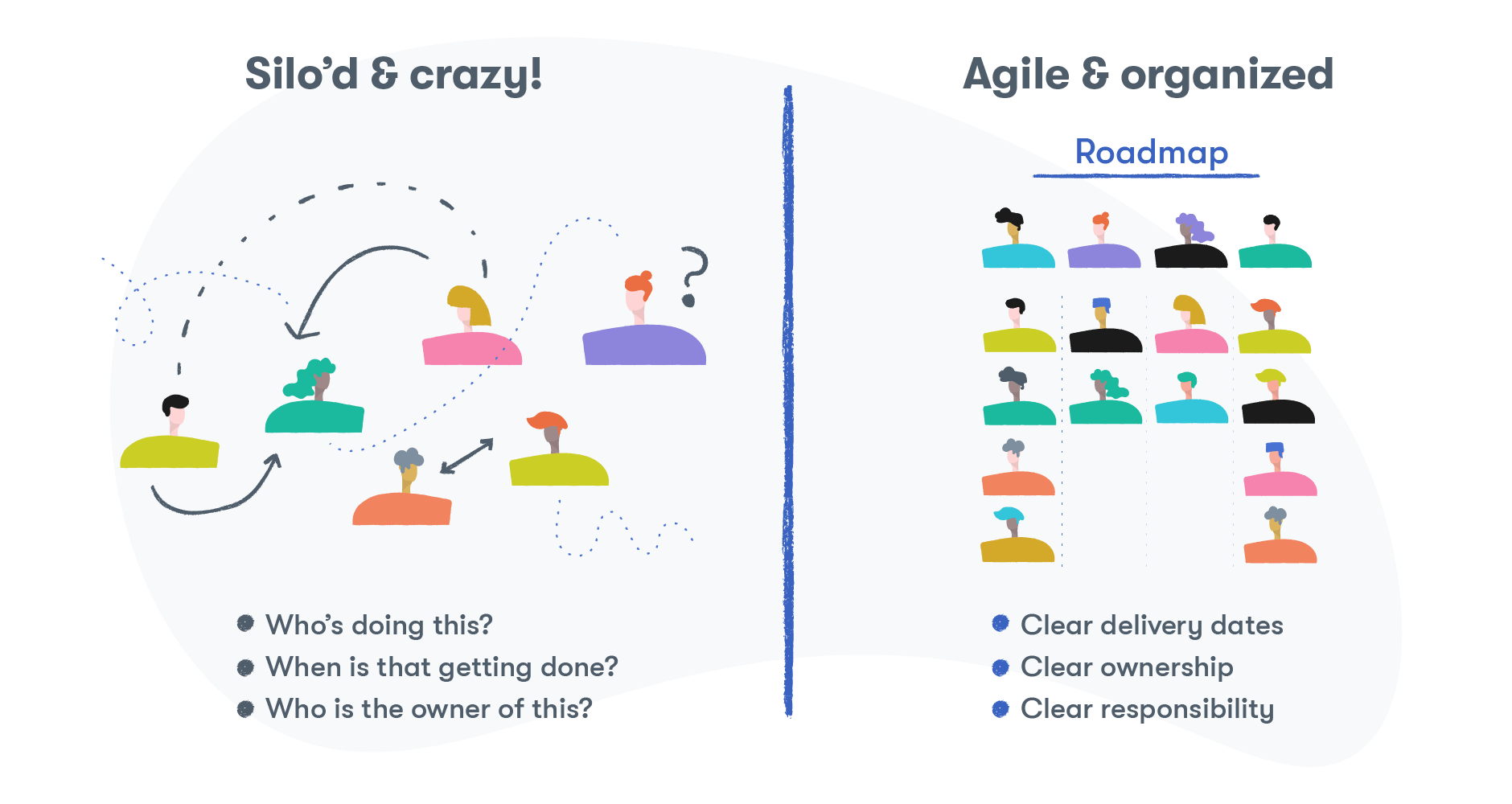
Track, verify… then trust
The primary reason I got burned in the past was that I’d trust first, track and verify second. Acting like “startup” Alex—scrappy, entrepreneurial Alex (as a opposed to business-owner Alex)—worked brilliantly when that’s what we were. At scale, it’s a recipe for disaster.
I will never ever, ever get burned again. And you don’t need to get burned either.
This may sound harsh, but business-owner Alex trusts only after he verifies.
How? By aligning someone’s role and responsibilities with trackable metrics and then ruthlessly verifying the value they’re creating is 100% a direct reflection of those goals.
Step 11: Make it about them, not you.
Your people are the key to your success. As you begin to scale, embrace the fact that you’ll need structure, organization and different types of people on the team—people who are world-class specialists at what they do, not simply generalists who figure things out as they go.
12. Pay attention to bottom-line metrics and cash flow
We nearly hit rock bottom. Yep. There was a dark time in Groove’s history when our startup nearly died. Not once, but twice. Both led to the organizational shake-ups I mentioned before that we desperately needed.
The first time was 2013. This was the weekly email I dreaded that came from our metrics provider.


We knew content marketing would be a long game, but we hoped for at least something to budge. At least a sign that we were on the right track.
But that didn’t happen.
We had spent so much time building the product, trying to get it perfect; feature after feature. Weeks poured into building the most amazing website that was inspired by countless hours of examining the competition.
To scale up, sometimes you have to scale back.
This saved us. Our cash flow should have been a wake up call earlier, but we spun our own spider web and got caught in it at the same time.
Alongside many of the other lessons, the centerpiece in moving past each breaking point was to obsessively track and set aggressive goals for growth. In short, you’ve got to have your basic KPIs mapped out, preferably feeding into a dashboard that you and your team discuss on a quarterly basis.
While I can’t share all the numbers, here’s exactly what we track week in and week out using Supermetrics and hand-entered data:
- Website visitors (total)
- Onboarding flow: sign-up to new free trials
- Trial to paid with a two-week lead time
- MRR (monthly recurring revenue)
- Accounts and total “agents” (Groove users)
- Voluntary church post-60 days

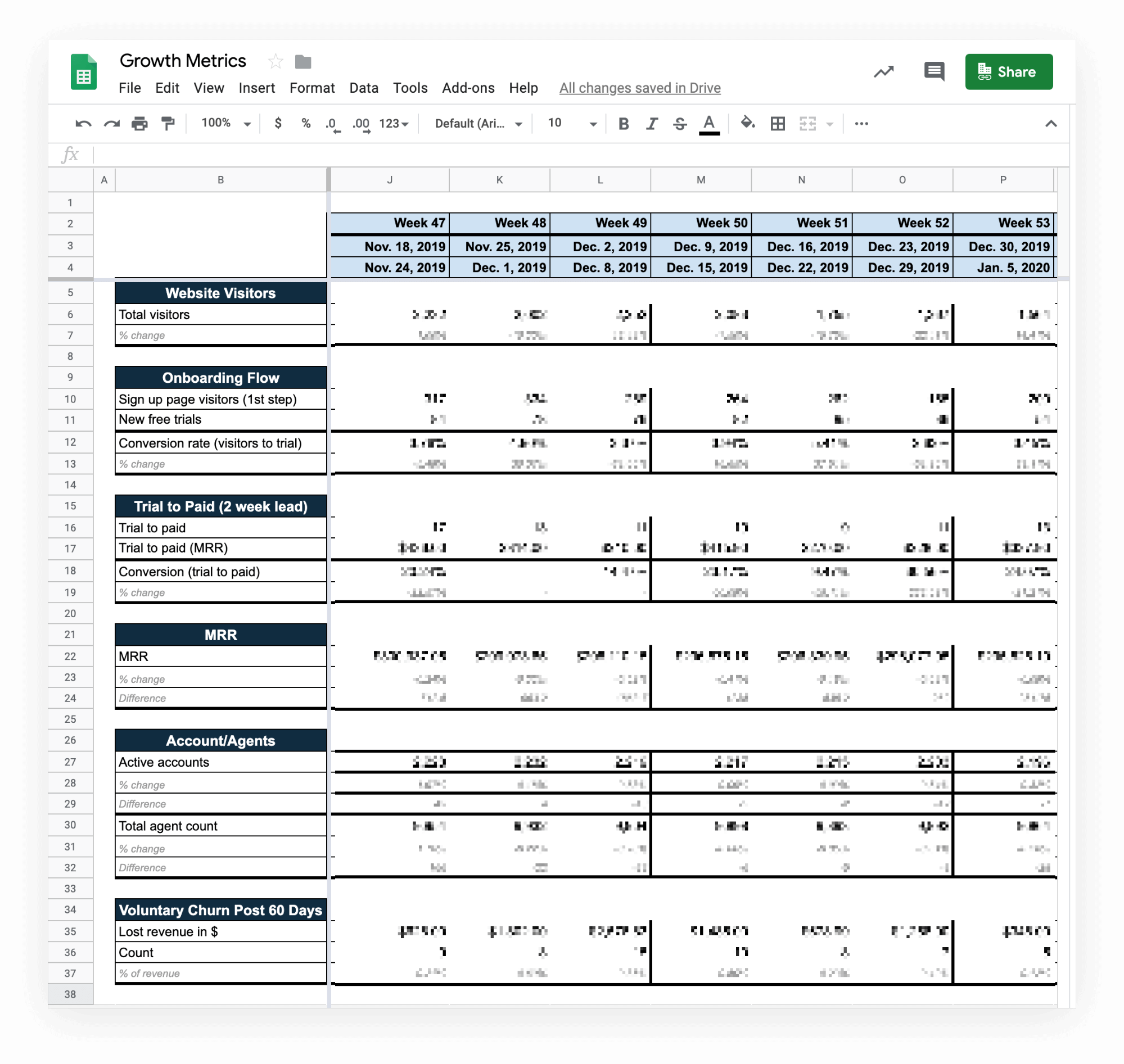
The marketing and content team likewise abides by tightly-monitored KPIs:


Dashboards and reports like these are just the tip of the metrics iceberg. Behind them are tabs and tabs and tabs of data.
However, everything has to roll up into easy-to-read single sources of truth.
Make sure that you’re looking at your qualitative and quantitative data so that you formulate key results that are in line with those goals.
While we do set revenue goals, there’s no “number” that represents a finish line for us. We’re in this to grow Groove into the best customer experience software company on the planet—though not necessarily the biggest.
A short ‘rant’ about cash flow and investors
Cash flow is a funny thing. Tragically, most founders are less worried about sustaining cash flow within a profitable company versus spending money they don’t have in order to grow. When you fall for the latter, that’s where debt and investors can turn ugly.
At Groove, we manage cash flow with a rigid mindset—even at the expense of potentially not growing as fast if that means raising money, taking on risk, and giving up control.
Too many people take the crutch provided by investors, institutions, VCs (venture capital), and angel investors because they don’t want to look at how they can build a profitable business.
To put it bluntly, they end up fucked either from the get go—by taking on too many founders and too many partners—or they put themselves in a corner where they have to grow massively.
Even if it’s a small amount in the beginning and you’re not priced right in terms of the valuation, the result can still be: “Oh shit. We have to be a $200 million company for me to have any upside. Okay, I’ve just got to go out and feed the beast.”
That’s not to say that all funding is bad because it all comes in different phases, but you need to be dead set on where you are and where you want to go.
Step 12: Fuel your scaling efforts by the numbers.
You don’t necessarily have to adopt a rigid mindset when it comes to managing cash flow, but you should have basic KPIs figured out. Discuss them regularly with your team and make sure they continue to align with your overall business goals.
13. Leverage growth strategies, not ‘growth hacks’
Many of our big wins at Groove haven’t been tactical.
- No A/B tests of button colors
- No swapping icons and images
- No playing with email send times
We’ve done those things. And we’ve gotten some results from them. But they’re not the big wins. Maybe one day we’ll be big enough where changing our button color makes a material impact on our bottom line.
Our big wins—the ones that actually push the business forward—have come from (1) finding upsell paths in the sales funnel and (2) building a repeatable and profitable sales process.
Let’s break down how this works when you’re trying to acquire new customers and push them through the funnel.
Top of the funnel: Attracting new users
Before we started blogging, traffic would come in bursts when we got news coverage or social media buzz. That’s not a sustainable way to grow, and we knew that we needed a better long-term strategy.
We began to think about what startups and small businesses would find useful, and we started writing those pieces. One post was accepted as a guest post submission on OnStartups, and another was syndicated by Business Insider. We even studied successful small business-focused blogs and created a 44-point checklist that listed the elements that we thought made those blogs work.
Our early blogging was hardly groundbreaking. But it didn’t need to be. To go from 100 visitors per day to over 1,000 was more than we needed to jumpstart our growth, and that traffic was mostly due to a few pieces of content that our audience was able to learn from:

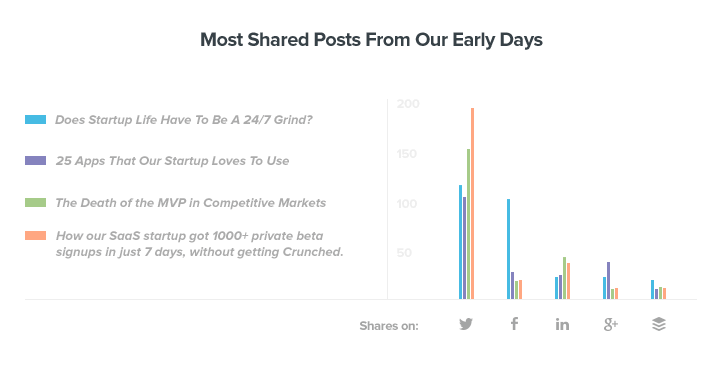
Of course, our inbound strategy has been (and still is) constantly evolving, and we’re seeing returns now that dwarf what those first few posts brought in (and yes, I’ll be writing about that). But that initial step of starting to blog was the most important one.
The other strategy that helped us move the needle on user acquisition was…
Middle of the funnel: Acquiring new users
One afternoon, frustrated by the lack of progress in our acquisition efforts, I decided to start asking our newest users how they found out about us. I didn’t put together a survey or set up an email blast. I just sent a quick, personal note to the last 20 people who had signed up.
That email turned out to be one of the best marketing decisions I ever made. What I heard back was absolutely enlightening.
Of the 14 users that responded, eight of them replied that they saw an awesome help widget on the website of a company that they loved, and they emailed those companies to find out who was behind their helpdesks.

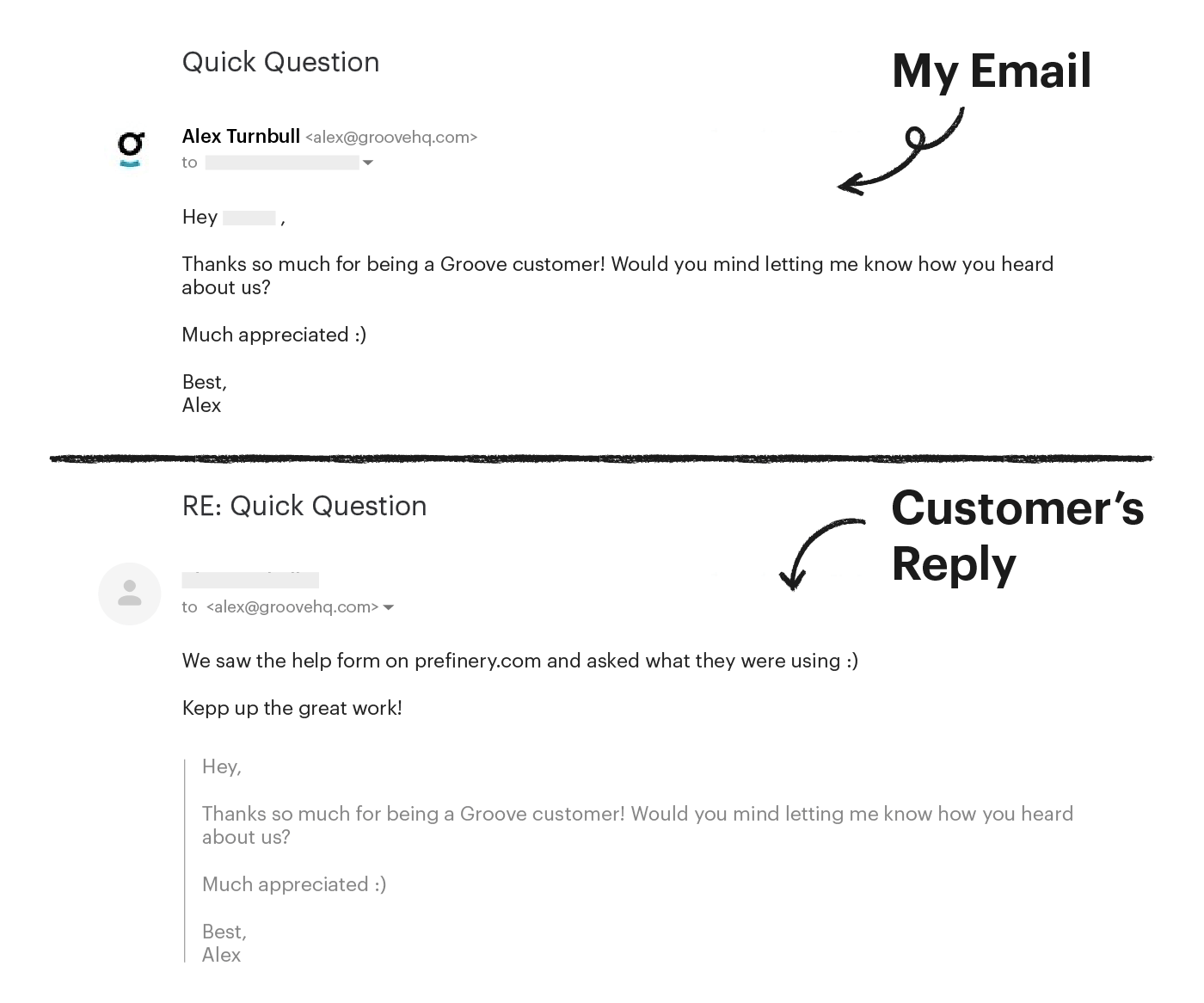
People were coming to us because they saw our product, and they had to ask our customers who we were.
We were hiding from incredibly high-value prospects in plain sight.
If those eight customers loved what they saw enough to put in the effort and track us down, how many potential users were out there who never bothered to follow up?
As it turned out, a lot. Two days later, we pushed a change to the Groove help widget. We added a small hyperlink that said “Powered By Groove” that directed customers to our site.
The impact was immediate. Within three days, 100 visitors came to our site through the widget, and 19 of them became customers.

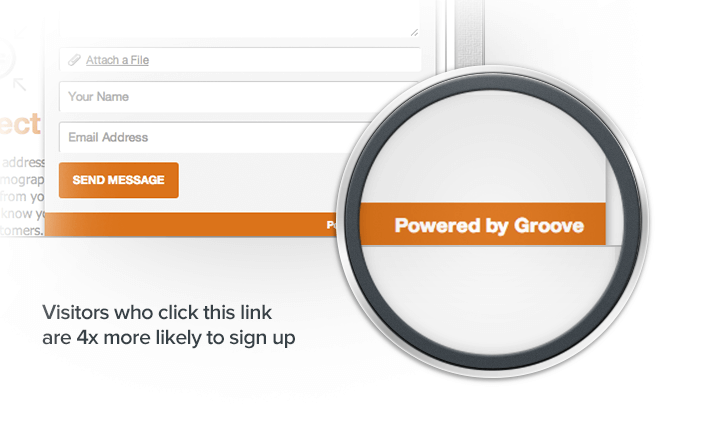
Bottom of the funnel: Activating new customers
More than any other challenge, activation was our primary post-launch focus. If you can’t get users actually using your product, then your acquisition efforts are all for nothing.
When it came to overcoming the activation challenge, the first piece of the puzzle was to optimize our onboarding process.
Groove simply had too many features. It was overwhelming for new users.
Because of that, we had a seven-step onboarding flow that took about seven minutes to complete. It asked the user to engage with nearly all of our features, and it turned out to be a huge abandonment point.
A few years ago, only 15% of users who began our onboarding flow would continue all the way through it.
The product issue was hurting us in more places than just activation, and we were forced to strip it down by removing several ancillary features, and putting other features and integrations in an “App Store” that would only be accessed by a user after they were engaged.
We also asked our most engaged customers what their “wow” moment with Groove was. The one when they knew that this was the right tool for them.
The responses we got made it clear that for most users, the “a ha moment” came when they created a mailbox and looked at their new dashboard.
The metrics confirmed it: users who created a mailbox during their first session were nearly six times more likely to return for a second visit. We scaled the flow back and focused it on getting users to complete that single, simple task.
The result? Over 4X the engagement.

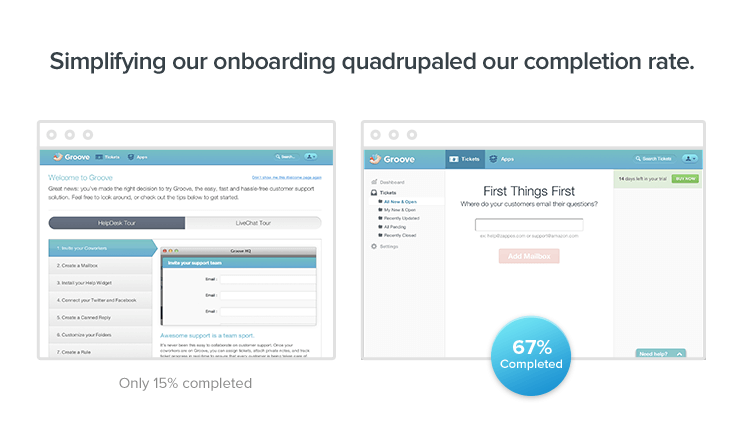
That’s a huge boost in activation, and it all came about from looking at usage metrics and talking to our users.

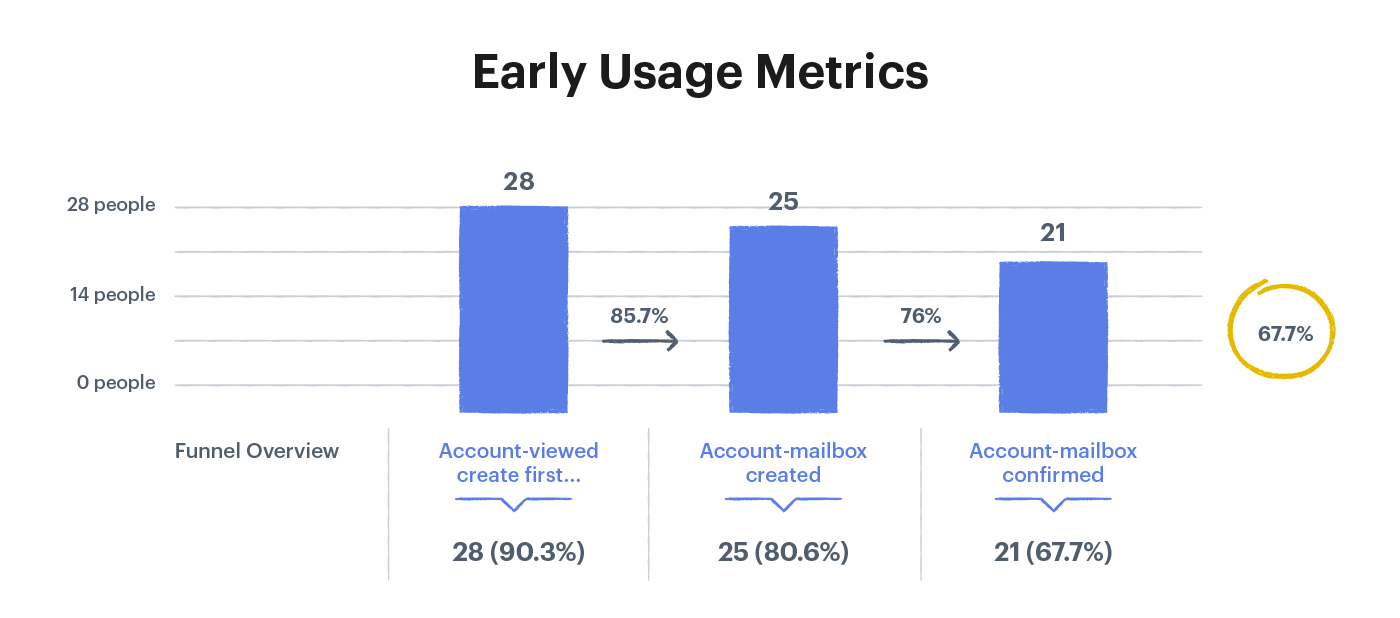
Since we knew that the big challenge was getting users to create a mailbox, we set up the autoresponder for free trial users to focus on that single call to action.
Any user who didn’t create a mailbox during their first session would get an automated email to nudge them back to that simple little task.


We saw within two weeks that users who received the activation emails were 18% more likely to stick around than users that didn’t.
Step 13: Know your funnel (top to bottom and back again).
Make sure you know where your most valuable customers are coming from, and double down on those channels.
Find out where the friction in your onboarding process is—and get rid of it. Know what your product’s activation triggers are and do everything you can to get your users to complete them.
14. Listen to and love your current customers
I’ve said it before, but customer development is an ongoing process for us.
We find every opportunity to connect personally with our customers and encourage them to share their feedback. It helps reduce churn and identify the leaks in your acquisition and retention strategies.
In fact, we made the announcement that we were lowering all of our prices by 30% in 2020. Why? Because we never want price to be the reason that a small business doesn’t choose Groove, or continues to stay with us.
A lower price means we’re going after more scale, but the other part that goes hand in hand with price is value.
No matter what price you put on your product or service, the customer still needs to feel that they are getting value from what they’re paying.
Here’s how we’ve addressed the “value leak” and retained our current customers.
Automated ‘nudges’
The automated activation emails mentioned before didn’t just serve to engage first-time users.
By continuing to send automated “nudges” to existing users after they became active, we introduced new features and functionality in a much more digestible way, which ultimately led users to get far more value out of using Groove.


These engagement emails helped us drop 30-day abandonment by almost 20%. We also had another secret weapon in the battle against abandonment.
Offering free support during their trial
As we started to track everything more closely, we began to notice a trend: the small subset of free trial users who emailed us for support were nine times more likely to become paying customers by the end of their trial than those who never reached out.
It’s a bit counterintuitive (which is why you must test every assumption), but my suspicion is that this is due to those customers simply putting more value on (and getting more value from) Groove from the very beginning.
If they weren’t getting great value from us, they likely wouldn’t bother asking for help when they hit a snag.
So, following the 80/20 rule, we doubled down on free trial support. We made the contact links more prominent and began to send calls to action encouraging users to reach out to us if they needed help. We were able to achieve a 20% lift in the number of users who did actually reach out, and we started focusing on making sure that those users had absolutely “wow” experiences.
Step 14: Love your customers at scale.
Failing to really listen to your customers and show them you care can lead to churn and create leaks in your sales funnel. Future proof your business by finding ways now to help your users get value out of your product.
15. Create an (even more) kick ass experience
Beyond actual product enhancements, we’ve been able to improve the customer experience by making everything around the product better.
- Better email onboarding helps customers get productive faster
- Proactive support makes customers comfortable
- Behaviorally-triggered emails get “at-risk” customers back on track
In addition to pricing changes, we’re also working on more core enhancements, new features, and new products. This includes two of the biggest requests we’ve had from our customers over the last two years.
Number one, building a new live chat feature which will be available on all current Groove plans. Number two, a deeply extended CRM.
All that’s great, but it’s actually not the point.
The point is that product development is second to customer experience: marketing, selling, and solving the problems that got you into business to begin with.
Scaling organizations regularly fall into the trap of adding features for the sake of adding features. This is even more true if you pay too much attention to your competitors.
Step 15:
Product development has to be in the service of better experiences. Even if you’ve reached product-market fit, there will always be more you can do to make customers fall deeper in love with your solutions.
Business growth: The adventure that never ends
By no means have we reached peak growth. We’ve still got miles in front of us.
That’s what makes growth such an adventure.
Flooded with uncertainty? Yes. Professional stress with no barrier to personal hardship? Absolutely. A manic road of highs and lows? Of course.
But, a road worth the journey? Without a doubt.
On that note, let me end with three questions:
- For those of you launching, what’s the driving pain behind your business?
- For those growing, what tactics have helped you move beyond “zero to one”?
- For those scaling, what’s the single-greatest lesson you’ve learned as a leader?
Oh, and if you’ve made it this far without downloading the full guide, here it is one last time. Remember: build that email list 😉…


